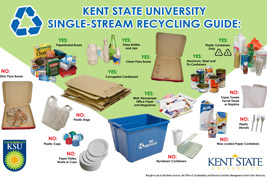Featured Article
Put Your Money Where Your Heart Is: A Mentorship Made in Media Heaven
Stepping into the TV2 news studio in Franklin Hall is like transporting onto the bridge of the starship Enterprise – a little disorienting, very cool, and so high-tech it makes the facilities at many small-market TV stations look positively stone age by comparison.
read moreThe Rules of Recycling
Posted April 16, 2012 | Ryan Collins
This handy chart shows what can and cannot be recycled.
With only 17 percent of Kent State University’s waste currently being recycled, Melanie Knowles, sustainability manager at Kent State’s Facilities Planning and Operations, says there is a lot of room for improvement. This passion for sustainability led to Knowles holding her current position.
“We all need to be more conscious of the products we are using: where they came from, where the waste is going, and the economic, human and environmental cost,” Knowles says. “Sustainability is not only possible, but is the only long-term option.”
Below is a simple guide on recycling at Kent State:
Rule No. 1: Know what is recyclable at Kent State and what is not.
- What can’t be recycled: Lids and caps, Styrofoam, plastic bags, straws and some plastics.
- What can be recycled: Plastics no. 1 and no. 2, like water bottles, detergent bottles and some food containers, as well as paper, cardboard and paperboard, glass, aluminum and steel cans.
- Tip: Anyone unsure about a plastic can look for a triangle with a “1” or “2” on the container’s bottom.
- How you can help: Knowles says the most common recycling contamination is food. “Bottles and containers should be emptied before going in the recycling bin,” she says.
Rule No. 2: Keep recycling and trash separate!
- What can’t be recycled: A bag with a little bit of recycling and lots of trash.
- What can be recycled: A bag with a little bit of trash and mostly recycling (but Kent State can be charged to remove this trash, so try not to).
- Tip: If you don’t know what is trash or what is recycling, refer to this handy chart from Residence Services, the Office of Sustainability, and University Facilities Management.
- How you can help: Kent State uses single-stream recycling, which means recyclable materials like paper and plastics don’t need to be sorted. If you see a blue bin, you can toss any of your recyclable waste in it. Plus, Kent State sometimes uses split trash/recycling bins, so be aware of which side your waste is going into.
Rule No. 3: Recycling in itself is not the only way to help make Kent State more environmentally friendly.
Knowles points out that recycling is listed at the end of the famous phrase, “Reduce, Reuse, Recycle.” “Reducing waste and using reusable items like water bottles, bags and silverware saves even more money and resources than recycling,” she says.
Recycling bins are available inside and outside campus buildings, including at Risman Plaza, which means that no one needs to go far to recycle.
If you know of a location that needs a new recycling bin or if one is needed for a special event on the Kent Campus, contact Knowles at 330-672-8039.